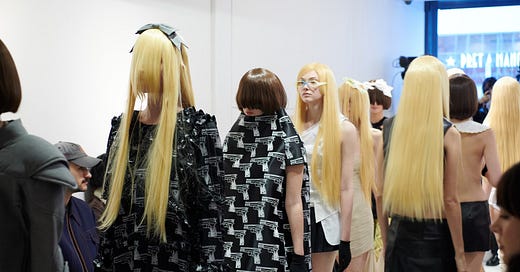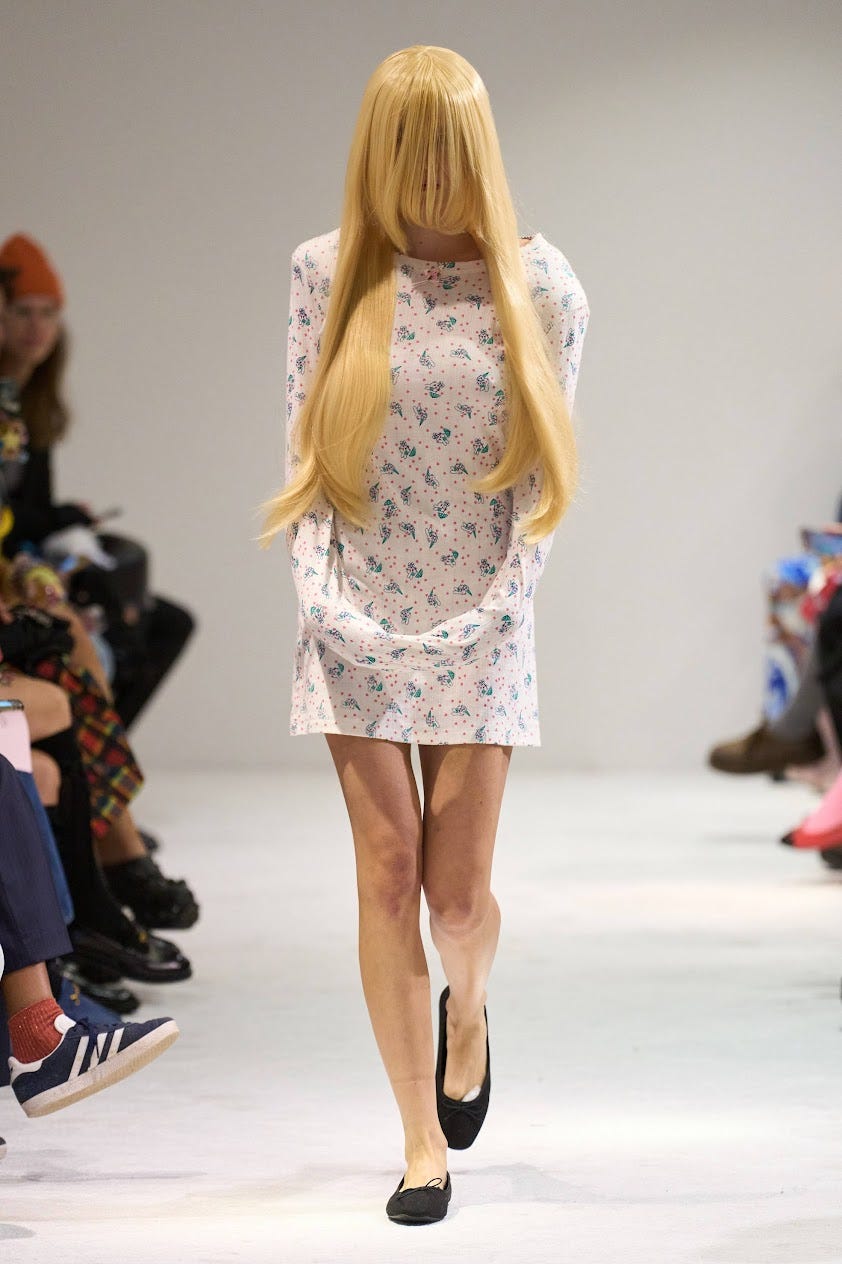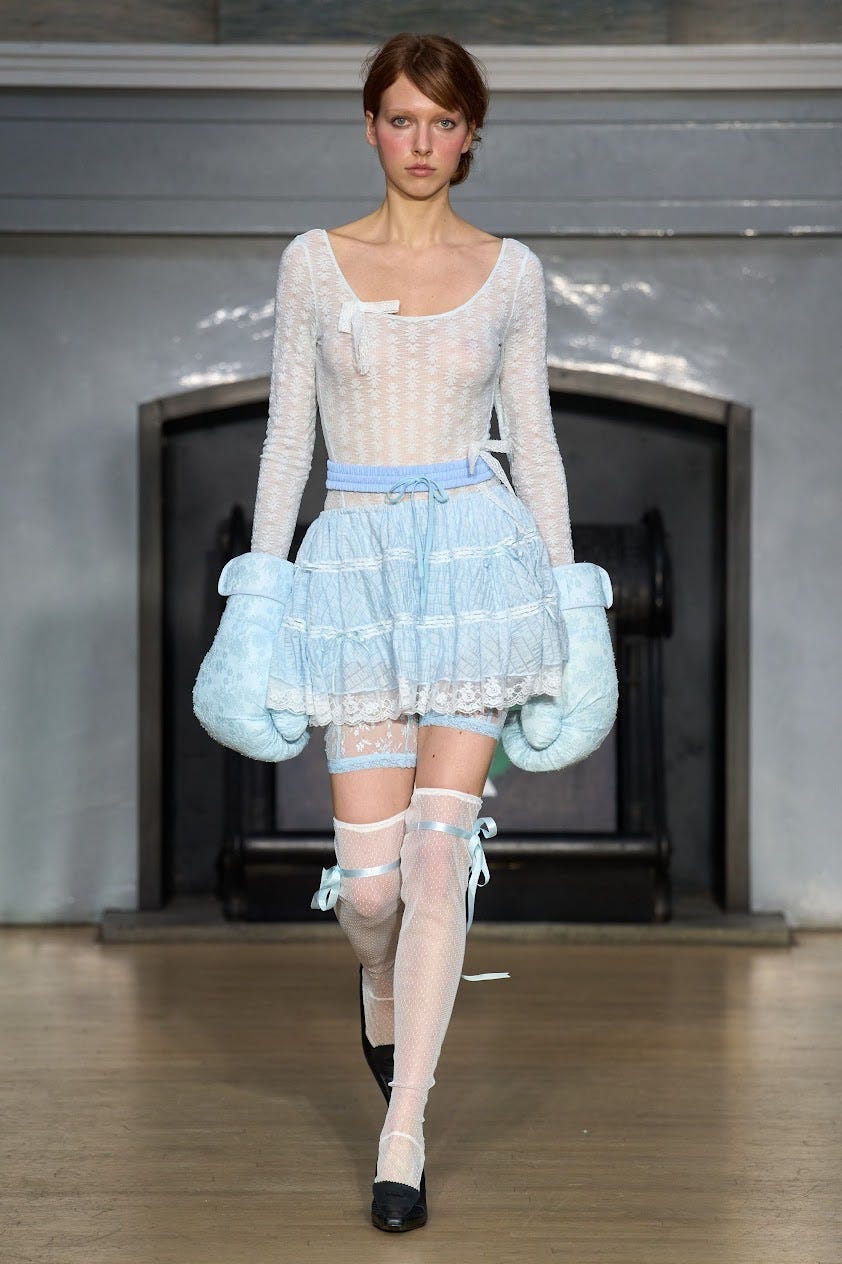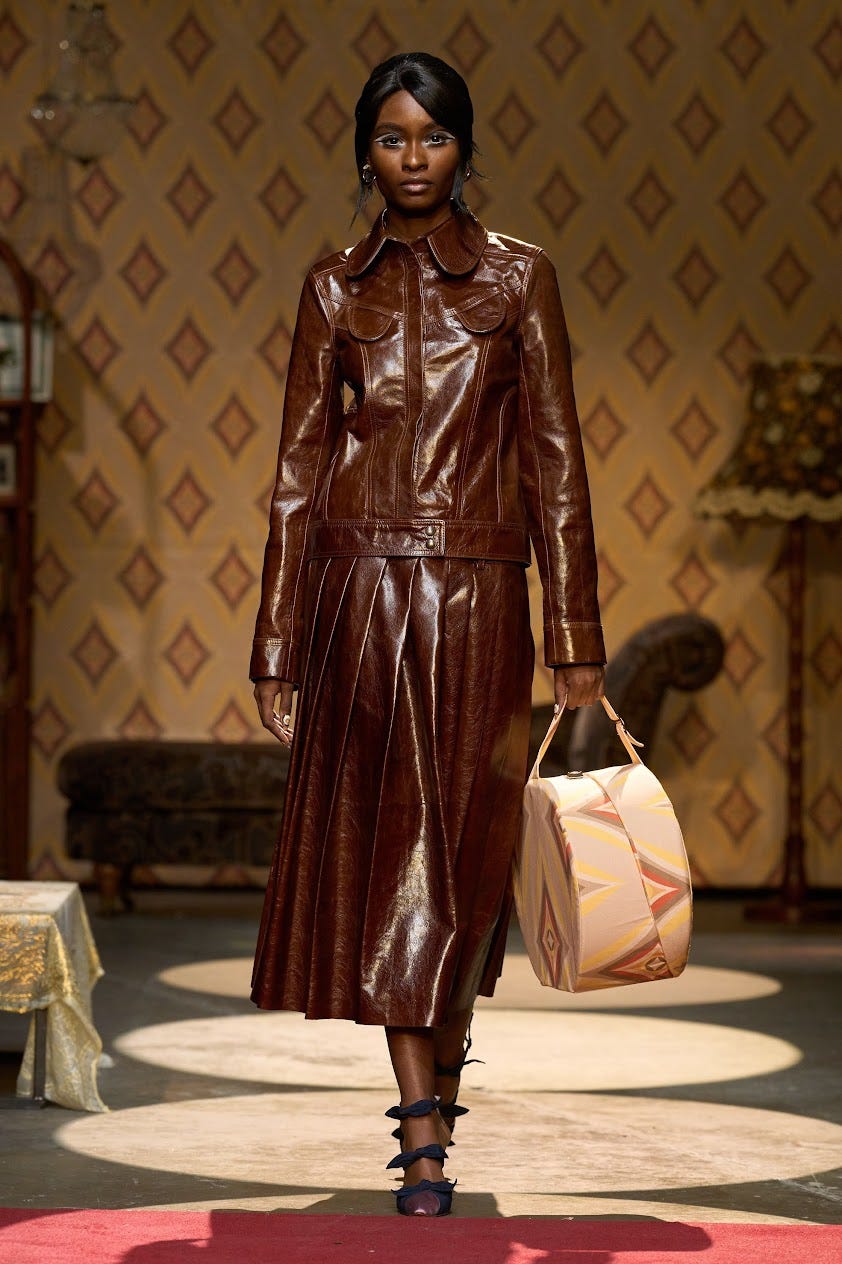London Fashion Week always leaves me with new friends.
Most established designers who got their start in the UK now show in Paris or Milan, including members of London’s diasporic indie class like Kiko Kostadinov, Wales Bonner, and Martine Rose. The big London names that dominate headlines are fewer and farther between anyway and haven’t been highlights in years (remember the last good Burberry show? McQueen? McCartney?) So who’s left to show in London? New designers, houses experimenting, rebrands, in other words, new friends.
One clique to watch was a group experimenting with the cutesy, a domineering force in fashion alongside its four horsemen: bow, lace, pearl, ballet flat. Ashley Williams has one foot in, one foot out of this kind of coquette-core. Half of her show displayed Sailor Moon iconography alongside angry, pointed jabs at cuteness. There are onesies that seem almost diaper-padded, blond wigs that grow shaggy and envelop the eyes and face, and patterns that mash and clash against drooping shoulders and raised skirts. Maybe then it isn’t such a left turn when charms and brooches reveal themselves as knives and guns, pistol print minidresses hike up high, and leather skirts pack revolver outlines in the belly. Williams plays with infantilization and agency as very literal, disturbed elements in her clothing, brought to the surface of what once could be a pretense, laid bare and bizarre.
The high collars and layers at Bora Aksu presented a similarly avant, if not adult approach to the frills and lace. The garments were inspired by the designer’s late mother, her hobbies, her craft, and her hand me downs like one “white mini dress, hand-stitched with ostrich feathers”. The result echoed the grace of Shushu/Tong’s elegant inversions of conservative vintage dress but here used as a base for increasingly complex displays of knitwear and craft. There are intricate crochets that web their way across pastel dresses or clump into flowers, layers upon layers of wrapped tulle, and capes that wrap and fall gracefully and unexpectedly. Sometimes the traditional is warped with a blood red coloring, other times a look will seem as conservative as its source on paper - stark white dress in lace and tulle, floral embellishments at the high collar, long lace gloves, white sunglasses with a slight wing, and of course, ballet flats. Bora Aksu makes even this feel tinged with new subversion, the replacement of commerciality with emotionality.
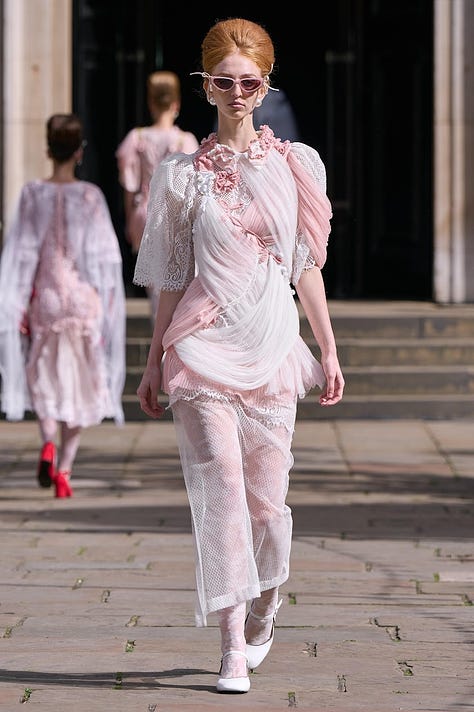
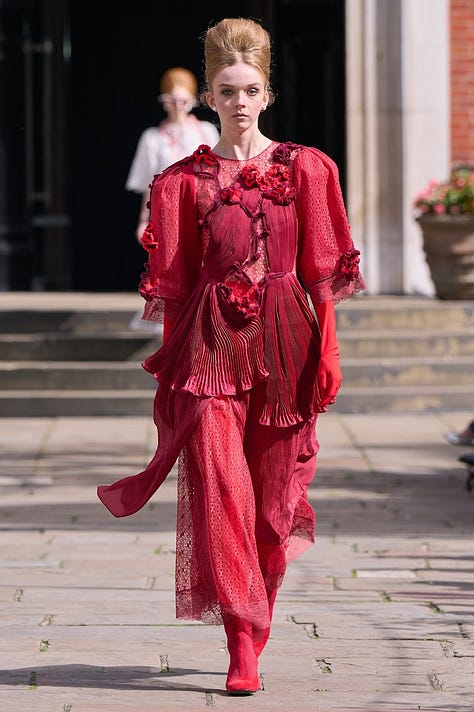
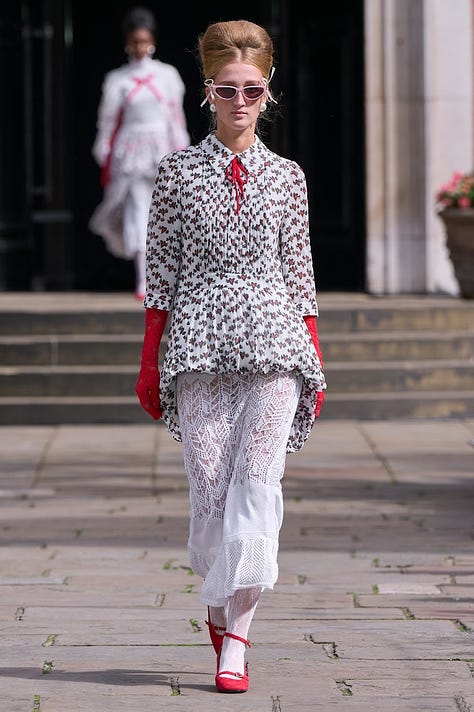
The coquette proposed by Yuhan Wang is also odd, but easier to digest: what about cute athletes? What if bloomers went with heavy shoulder pads, lacey slips with pastel boxing gloves, and jerseys layered over frills? To bring athleticism into an aesthetic language that signals fragility, preciousness, immobility (see short skirts, flimsy shoes, satin and silk, whites and eggshells) is not without its politics and implications, but a reliance on the conceptual stopped the show from feeling quite as pragmatic.
“Pragmatic“ is inversely a slogan for coquette-core offerings, and keeping the styling and garments approachable and wearable amidst their critiue may have been more convincing. It’s a fine line. The looks were costumes, mixtures of tropes and symbols, more like two worlds transposed on the other than a formalized and context laden dress. Still, it was more interesting to see the coquette toyed with and treated like the plastic aesthetic it is. Anyone can bring in a new pastel, lace placement, and bow.
On that note, it’s fascinating to consider these new directions when compared to more traditional visions of this aesthetic. One of the most criticized of last week’s New York shows was Sandy Liang (a stateside proponent of this aesthetic). Her show notes defined Liang’s characters of the season in a way many argued was at best underbaked and poorly written, at worst regressive and anti-feminist. I recently heard the phrase, “Writing about art is like dancing about architecture” and in this case that saying is appropriate. Moreover, the show itself is as bland as its treatise, as uninspired, as available for construing the garments as simple and dated perspectives on femininity. Simone Rocha's show, this season a deeply commercial, sanded-down delivery of these aesthetic mainstays (you could play bingo looking for all the tutus and pale pinks and rubies if it wasn’t so easy) was more complex for its basic daring to include men, and real characters and contexts who could exist with her work
Other cliques were more formally structured , like the Fashion East show featuring Ollie Shinder, Dodu, and Loutre. This exceptional cast was unified by gorp and technical dress.
Nylon sailor boys paraded for Olly Shinder, a standout look featuring a blankly inviting gaze, a floor length rat tail held delicately and twirled like a whip, and a fat black tie caged by strips of a camel nylon shirt. The latter reappeared often, sometimes in monochrome whites with suspenders, as did other forms of netting and miniaturized bondage: pants opening at the thighs and down the shoulders, netted v-necks, and wader style boots. Shinder’s work is growing increasingly avant, if not far steamier than usual, a welcome addition to an often all too straight and body concealing gorp.
Sometimes modest techwear assimilates into the world of fussy, overpriced, oversized top/skinny pants, earthen color palate, distressed aesthetics. There was a breezy arcanity to Nuba’s debut show, with its skinny pants and cloaks and hoods. Their garments rejected hype in favor of monkish sets of robes and wraps, old Rick Owens shapes in rich Helmut Lang mosses, cherry reds, and washed blacks. It was regal, serious, gorgeous clothing without any of the body consciousness and rigor of their peers (although Nuba’s models were certainly muscled). As these natural dyes come back into favor in gorp, alongside degendered dress, sex, and higher competition, Nuba’s natural touch will be one to follow.
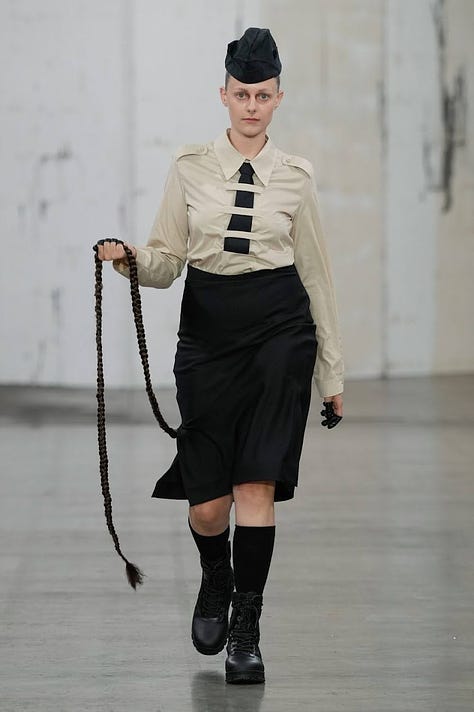
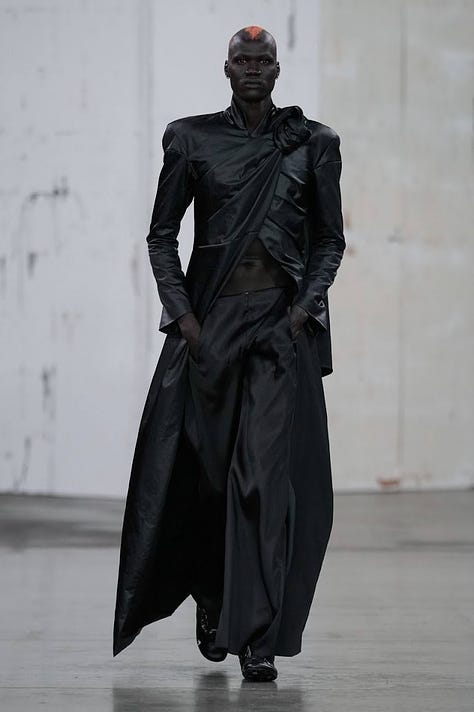

The highlight of Fashion East was easily Loutre who creates compelling tidied up mixtures of streetwear, tech, and generalized “everyday clothes“ through vintage deadstock and refabrication. Loutre has been one of the most successful at creating an aptly priced, sensible model for custom-feeling, sustainable, personal casual wear.
Loutre’s look is effortless street but without any sacrifice to maximalism.Three looks in and we had a sandy looking fur, a houndstooth coat cinched at the waist with a beret, and a slouchy double-breasted blazer. Each model wore gloves that hugged the fingers and thumb in plasticy reds and dull yellows. One could sense unified codes, but each was styled to present a compelling sense of character and occasion for each model. The double knee pant turned skirt embellished with crystals could have been a long weekend project before a momentous party, Yves Klein blue socks bring color to the patchwork coat’s rainy day beige, button patterns are random, and the textures of layered tops wrestle.
It’s not quite the eye of the hurricane unity of subcultures that creates these looks, as in a Martine Rose affair, it seems defined by the fluidity of materiality. When does the shimmer of fabric evoke nylon trackies, when does it become satin? Can workwear elevate the formal? What does the flash of a red leather glove do to a black dress?
Loutre has provided my favorite kind of fashion fantasy: one squarely rooted in wanting to bring the viewer into the creative process of wearing and styling. Their fantasy is to be appropriated to your world, to become personal.
Just as enticing as these cliques were the sole voices powerful enough to command attention without extensive connections or legacies.
The week’s most audacious spectacle, certainly one of the most effective and wearable entries, was Natasha Zinko’s ode to surgery. Specifically, Zinko was interested in the hidden recoveries from “vanity“ medical procedures. She spoke to the “trend“ of BBLs and their social media documentation via the bandage as accessory, a Napoleon hand in breast pocket echoing a cast, tops that echo surgery plans, and plastic gloves that look like body bags. Even when the show teetered on the obvious it was done smartly, the range being a “Who’s Your Surgeon“ tee (hope Neon doesn’t sue), a streetwearish x-ray graphic, to a tee shirt dress showing a Reddit post on BBLs. The straightjacket was another intertext for Zinko, an Alexander Mcqueen reference that spoke to a far earlier and more extreme relation to clothing as controlling body, and perhaps mind. What do clothes, what does “fashion“ do to these fragile bodies and minds?
The incredible thing about Voss, Mcqueen’s SS01 show with head bandaged models striding through a mental hospital waiting room, was that it was as filled with wearable clothes as it was showpieces. They were clothes that felt relevant to women as more than art, but as powerful and useful things to transform the body. Zinko’s work is uniquely as wearable as it is rhetorical. Beyond the flashy tees and cargo denim, I’m enamored by her high blue striped collars and straightjacket undershirts. If Mcqueen treated himself as patient in the little glass box at Voss, Zinko was the mad doctor, the surgeon, the one who cuts and stitches.
It’s disappointing that it makes news to use fashion as a means of pointed critique in a way that yields equal parts wearable work and effective commentary. Rarer still to keep the commentary alongside true sexiness. Zinko’s show may already be overshadowed by louder and less effective attempts at defining/criticizing fashion, but I hope it will last as far more prescient.
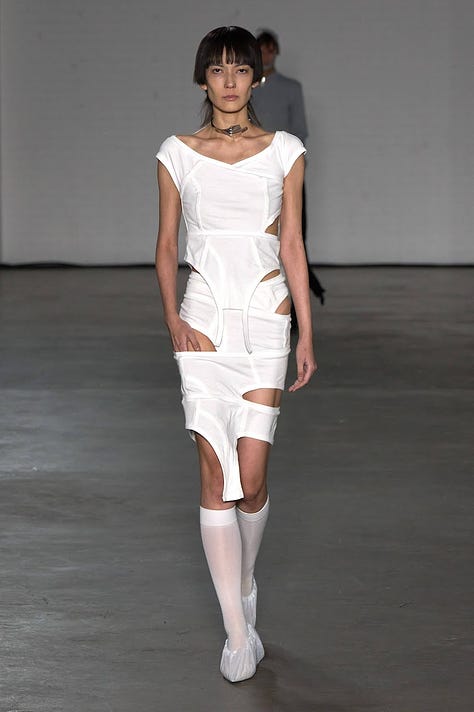
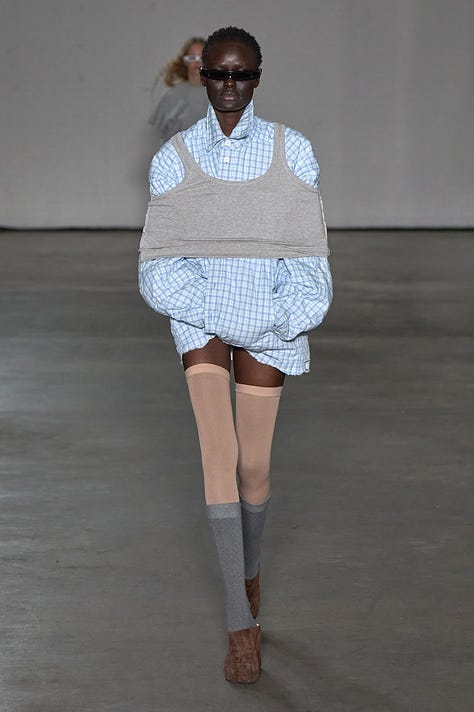
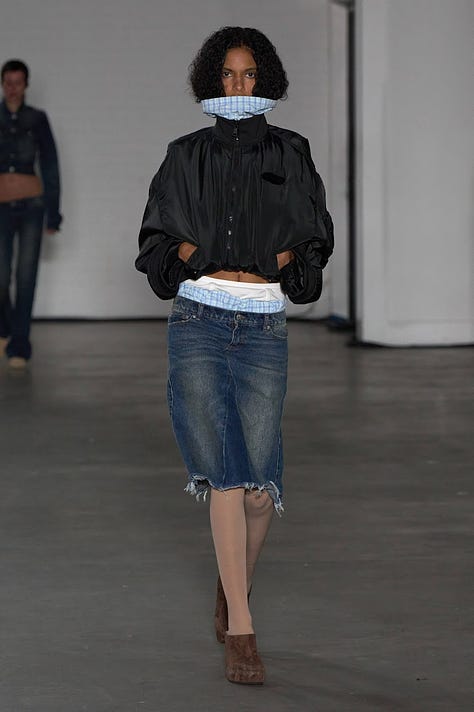
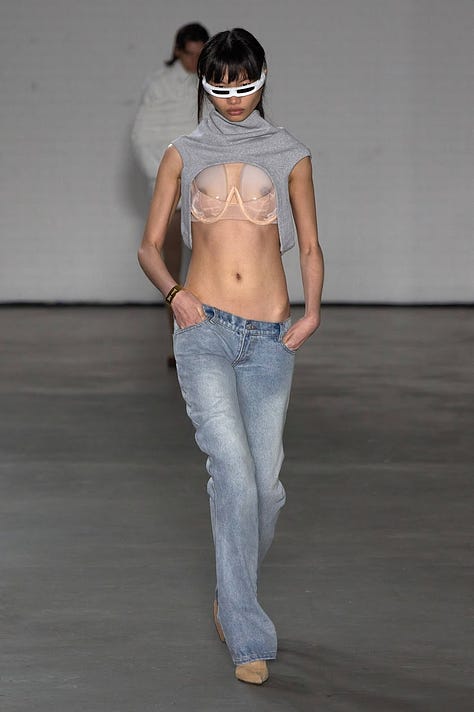
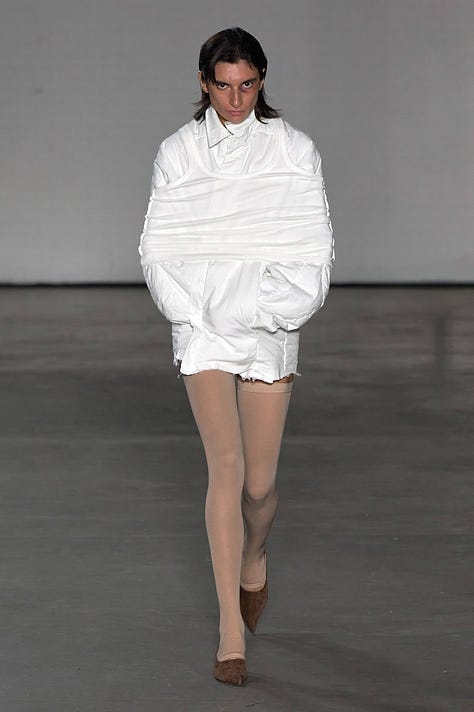
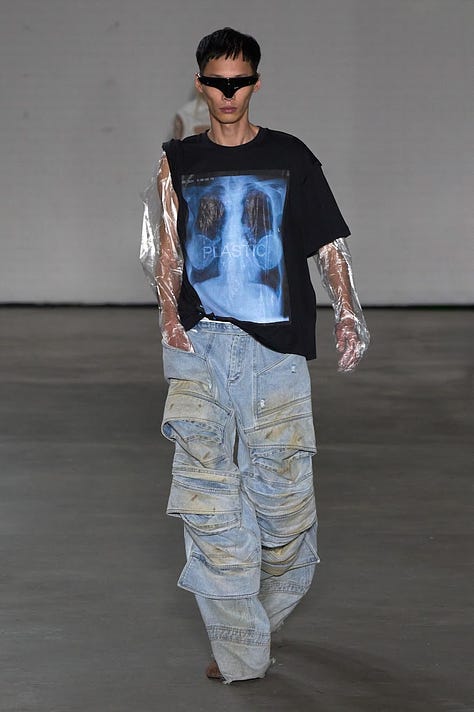
The British Fashion Council’s NewGen program helped give Tolu Coker the spotlight to show a high concept recreation of a 70s living room. Models donned warm psychedelic patterns, late 60s hairdos, and the contrast paneling of 70s sportswear. It was a time capsule - an ode to family history and London’s immigrant population.
Perhaps this is what made Coker’s clothes look so comfortable, so easy. A green leather coat can be an intimidating object, this one looked like one you may borrow from an older sister on a night out or a friend’s that they’ve wrapped around your shoulders. A baby blue houndstooth set was so oversized they resembled pajamas if not for being paired with big hoops. Throughlines tying these bright colors and patterns together included gorgeous sets, swinging pleated skirts, Peter Pan collars, contrast materials, crinkly leather, and a love of hats.
I’m a sucker for a joyous affair, and by all accounts, Tolu Coker was a truly happy one. Models danced the runway, and Coker rejoiced with a fan on Twitter about the happy rarity of an almost entirely Black cast (many fashion awards were deeply whitewashed this year). Few moments in fashion felt so rooted in a celebration of the familial, of in an emotive wearing, of in pure joy to gather and remember.
I can always talk about the old friends of London Fashion Week. I could write about SS Daley’s endearing and increasingly gender inclusive prep, its craft and crochets going hand in hand with a Queer inversion. I could write about Steve O Smith’s breathtaking continuation of made to order garments that resemble fashion sketches, ethereal and sheer. I could write about the sumptuous luxury of Richard Quinn’s work, a feeling of traditional splendor large houses dream of. I could write about a new Chopova Lowena top covered in graphics of apple slices.
But then, that is the beauty of London. Its new friends have a way of dazzling, of comfortably making room.


